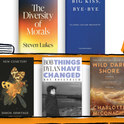A Brief Global History of the Left
by Shlomo Sand (Polity, £17.99)
What with the left’s notorious penchant for infighting, you could be forgiven for thinking there’s more that divides than unites it. Yet here, in this engrossing global history of the left, Israeli historian Shlomo Sand makes the case—very convincingly—that the true core of all leftist thought isn’t about the role of the state or the status of private property, but rather the pursuit of a single key principle: equality.
Taking us from the Levellers of 17th-century England to the Jacobins of the French Revolution, through the terror of Stalinism to the present day, Sand’s insistence that we judge all leftist ideology through the lens of equality is not just enlightening; it also helps explain the many supposed contradictions that arise when discussing such a diverse range of ideas.
Pierre-Joseph Proudhon, for instance, widely considered a father figure of anarchism, did not actually oppose all private property—only on the condition that the enjoyment of it did not depend on the undermining of another’s equality. While China’s combined communist-capitalist system has brought many out of poverty, it has also heavily stratified society. By that metric it could be more accurately described—as it is, cheekily, by Sand—as a liberal rather than a leftist state.
But although Sand’s clarity is often inspiring, it’s also what makes his assessment of today’s left so disheartening. Mass protest movements make us feel as though the left is as active as ever in the 21st century, although Sand points out that none of these protests have turned into any lasting political change. In a stark break with the trade unionism of the past, the modern left’s disillusionment with party politics has simply led to collective frustration without any clear sense of direction. Now is the time to remind ourselves what it’s really all about.
David McAllister
Bluestockings: The First Women’s Movement
by Susannah Gibson (John Murray, £25)
It was a time when women’s dress hoops regularly got caught in doorways and their names were absent from their own marriage announcements. The more educated a woman was, the more mockable most men found her. But the loose society known as the Bluestockings insisted on their abilities: holding salons, writing books, educating themselves freely.
The Bluestockings were perpetually interesting. They are a lively, witty subject for a book. Fanny Burney’s -novel Evelina kept Edmund Burke up all night. Elizabeth Montagu held Samuel Johnson in conversational thrall. Catharine Macaulay’s History of England was praised by Pitt the Younger and serialised in an affordable edition (she pooh-poohed the librarian who tried to stop her seeing letters from King James VI and I’s male lover). Hannah More described attending the opera as akin to getting drunk—a sin that carries its own punishment.
Though Susannah Gibson’s frequent parenthetical statements about 18th-century patriarchy are unnecessary—several of the men featured are quite enlightened, and the facts Gibson presents portray the patriarchy for what it was—Bluestockings is full of useful detail and keeps to a good length. This is everything you want to know, but no more.
It also has compelling details on people’s capacity for improvement. Hester Thrale’s children are testament to her talent as a teacher: her five-year-old read The Pilgrim’s Progress and the newspaper; her two-and-a-half-year-old knew the names of the planets, the points of the compass, many constellations, multiple capital cities and could identify most nations on a map.
Thrale herself exceeded expectations when she saved the family business from bankruptcy and made a small fortune. As with Hannah Yearsley, who went from being homeless to a well-known and remunerated poet, this is the true lesson of the Bluestockings: human potential is often bigger than we know.
Henry Oliver
Cloistered: My Years as a Nun
by Catherine Coldstream (Chatto & Windus, £20)
When Catherine Coldstream’s beloved dad died, she searched for a new father figure and found one in God. Aged 27, she decided to swap her bohemian north London life—punctuated by romantic adventures in Paris—for Akenside Priory (not its real name), a beautiful Northumberland monastery run by Roman Catholic Carmelite nuns.
Becoming a postulant, or nun-in-training, was a way to deal with her grief, Coldstream writes in Cloistered, her gripping memoir of her 12 years at Akenside. “My vocation sometimes felt like nothing more than a way of honouring him, of saying definitively to the world: My heart belongs to Daddy.”
Akenside nuns did not teach, nor care for the sick. Their days were devoted to prayer and self-denial. Coldstream (“Sister Catherine”) is open about the appeal of those intimate hours spent alone in a bare cell as a Bride of Christ. “Jesus was my spouse, my -everything,” she writes. “I was giddy with the power of it, head over heels in love. I closed my eyes and listened to his voice, a softness and a murmuring like the babbling of a brook… I opened my eyes and saw his own, burning green and brown, fixed upon me, everywhere.”
But trouble came in the form of other nuns. Coldstream felt painfully the stings of exclusion, rejection and criticism. A power struggle between two factions led to screaming abuse, humiliating forced confessions and, in one horrifying scene, a beating from the Reverend Mother.
When Coldstream finally escaped, she was astonished by her freedom. Twenty years later, now a married teacher in Oxford, she has kept her faith in God. She hasn’t returned to Akenside, but dreams of it often.
Emily Lawford
Becoming Ella Fitzgerald
by Judith Tick (Norton, £30)
Ella Fitzgerald never liked giving interviews, which helps to explain why jazz biography has struggled to get her right. But Judith Tick’s tenaciously researched book changes that.
Tick’s title is well chosen: Fitzgerald is always “becoming” something new, her stylistic experimentation helping to maintain a pacey narrative. Emerging during the 1930s Swing era, singing with pioneering drummer Chick Webb, Fitzgerald soon fell in with the coterie of young intellectuals, Dizzy Gillespie and Charlie Parker included, whose bebop was changing jazz as fundamentally as Picasso upended representative painting. Beginning in the 1950s, in a sequence of Songbook albums spotlighting the likes of George Gershwin and Cole Porter, she chalked up massive commercial hits.
After which, Fitzgerald toured the globe relentlessly, a certified jazz superstar, whose knack of keeping it simple while delivering a song granted her permission to unleash audacious vocal improvisations. Thankfully, given this artistic daring, Tick is a biographer unafraid and well able to grapple with how her subject’s music functioned technically.
Fitzgerald’s innate robustness—which surely helped her to persist through all those decades—derived from a childhood trauma: the loss of her mother following a car accident, when Ella was 15. This is related here with a wealth of new information. Some may remember her onstage persona as being like everyone’s favourite grandmother, but actually she was much tougher than that: she spoke out against racial bigotry, and brawled with record producers when the material they offered was beneath her. This fine account reveals one of the greats in an entirely new light.
Philip Clark
The Extinction of Irena Rey
by Jennifer Croft (Scribe, £16.99)
This is a thrilling read, particularly for anyone who fancies themselves au fait with the goings-on of the international literary world. In it, Jennifer Croft probes at the knotty relationship between authors and translators; riffs on the scandal of Filippo Bernardini, who in 2023 was found guilty of stealing manuscripts; and even refers to her real-life self, “the US translator of Olga Tokarczuk”.
Even aside from its jibes at the literary industry’s self-obsession, The Extinction of Irena Rey is immensely fun. The novel follows eight translators from around the world who arrive at the house of an esteemed Polish author to translate her next masterpiece. The translators idolise Irena, and view their semi-regular trips to her home, which sits at the edge of a primeval forest, as pilgrimages. But soon Irena disappears, strange things happen and they have to sift through her books and eccentric belongings to find clues that might lead them to her.
Like Drive Your Plow Over the Bones of the Dead by Tokarczuk, the Nobel laureate whose novels Croft is best known for bringing into English, The Extinction of Irena Rey is both a book of significant intellectual questions and a fast-paced thriller. In their quest to find Irena, the translators become obsessed with mycelium—the fungal network that stitches the plants and trees of a forest together into a communicating whole—and the Polish government’s new plan to triple the logging limits on the forest, which would devastate this ancient natural habitat.
The resultant tale merges conundrums both linguistic and ecological, and undercuts them with idiosyncratic humour—somewhat hysterically, the narrator of the -novel and its footnote-avid translator are each other’s mortal enemies. All of which makes Jennifer Croft a marvel.
Ellen Peirson-Hagger












